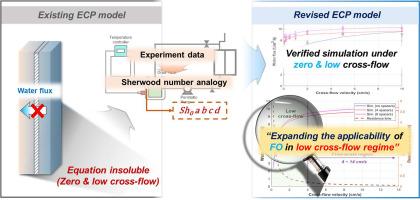零流和低流条件下正向渗透的新框架:适用性和与反渗透的根本区别
IF 12.4
1区 环境科学与生态学
Q1 ENGINEERING, ENVIRONMENTAL
引用次数: 0
摘要
由于传统的外部浓度极化(ECP)公式的局限性,在低或零交叉流速度下运行的正向渗透(FO)系统存在建模挑战,这些公式通常预测停滞条件下的通量接近零,与实验观察结果相矛盾。为了解决这个问题,我们提出了一个修正的ECP模型,该模型包含一个渐近舍伍德数,可以在雷诺数接近零时进行连续传质预测。该模型考虑了分子扩散和自然对流,可以在无间隔和低流量环境中进行准确的通量预测。模型参数根据实验数据估算,并通过水合包(零流量)和商业FO模块在0-10 cm/s横流速度下的模拟进行验证。模拟结果与实验趋势密切匹配,并成功地再现了不同工况下的水通量行为。敏感性分析显示,基线传质参数(Sh 0, a, b, c, d)的影响与固有膜特性(a和S)相当,特别是在无间隔系统中,扩散和边界层阻力占主导地位。这些发现证实了传质系数在FO性能中的关键作用。在低横流工况下,对采收率-通量-速度关系的分析证明了低速运行的可行性,并明确了与RO的关键区别。该模型支持最小流量条件下的FO系统设计,促进适用于便携式和混合应用的紧凑型模块的开发。本文章由计算机程序翻译,如有差异,请以英文原文为准。

A novel framework for forward osmosis in zero- and low-flow conditions: Applicability and fundamental differences from reverse osmosis
Forward osmosis (FO) systems operating under low or zero cross-flow velocities present modeling challenges due to the limitations of conventional external concentration polarization (ECP) formulations, which often predict near-zero flux under stagnant conditions, contradicting experimental observations. To address this, we propose a revised ECP model incorporating an asymptotic Sherwood number that enables continuous mass transfer prediction as the Reynolds number approaches zero. The model accounts for both molecular diffusion and natural convection, allowing accurate flux prediction in spacer-free and low-flow environments. Model parameters were estimated from experimental data and validated through simulations of a hydration pack (zero flow) and a commercial FO module operating at 0–10 cm/s cross-flow velocity. Simulated results closely matched experimental trends and successfully reproduced water flux behavior across operating regimes. Sensitivity analysis revealed that baseline mass transfer parameters (Sh₀, a, b, c, d) had influence comparable to intrinsic membrane properties (A and S), particularly in no-spacer systems where diffusion and boundary layer resistance dominate. These findings confirm the critical role of mass transfer coefficients in FO performance. In the low cross-flow regime, analysis of the recovery–flux–velocity relationship demonstrated the feasibility of low-velocity operation and clarified key distinctions from RO. The model supports FO system design under minimal flow conditions, facilitating the development of compact modules suitable for portable and hybrid applications.
求助全文
通过发布文献求助,成功后即可免费获取论文全文。
去求助
来源期刊

Water Research
环境科学-工程:环境
CiteScore
20.80
自引率
9.40%
发文量
1307
审稿时长
38 days
期刊介绍:
Water Research, along with its open access companion journal Water Research X, serves as a platform for publishing original research papers covering various aspects of the science and technology related to the anthropogenic water cycle, water quality, and its management worldwide. The audience targeted by the journal comprises biologists, chemical engineers, chemists, civil engineers, environmental engineers, limnologists, and microbiologists. The scope of the journal include:
•Treatment processes for water and wastewaters (municipal, agricultural, industrial, and on-site treatment), including resource recovery and residuals management;
•Urban hydrology including sewer systems, stormwater management, and green infrastructure;
•Drinking water treatment and distribution;
•Potable and non-potable water reuse;
•Sanitation, public health, and risk assessment;
•Anaerobic digestion, solid and hazardous waste management, including source characterization and the effects and control of leachates and gaseous emissions;
•Contaminants (chemical, microbial, anthropogenic particles such as nanoparticles or microplastics) and related water quality sensing, monitoring, fate, and assessment;
•Anthropogenic impacts on inland, tidal, coastal and urban waters, focusing on surface and ground waters, and point and non-point sources of pollution;
•Environmental restoration, linked to surface water, groundwater and groundwater remediation;
•Analysis of the interfaces between sediments and water, and between water and atmosphere, focusing specifically on anthropogenic impacts;
•Mathematical modelling, systems analysis, machine learning, and beneficial use of big data related to the anthropogenic water cycle;
•Socio-economic, policy, and regulations studies.
 求助内容:
求助内容: 应助结果提醒方式:
应助结果提醒方式:


